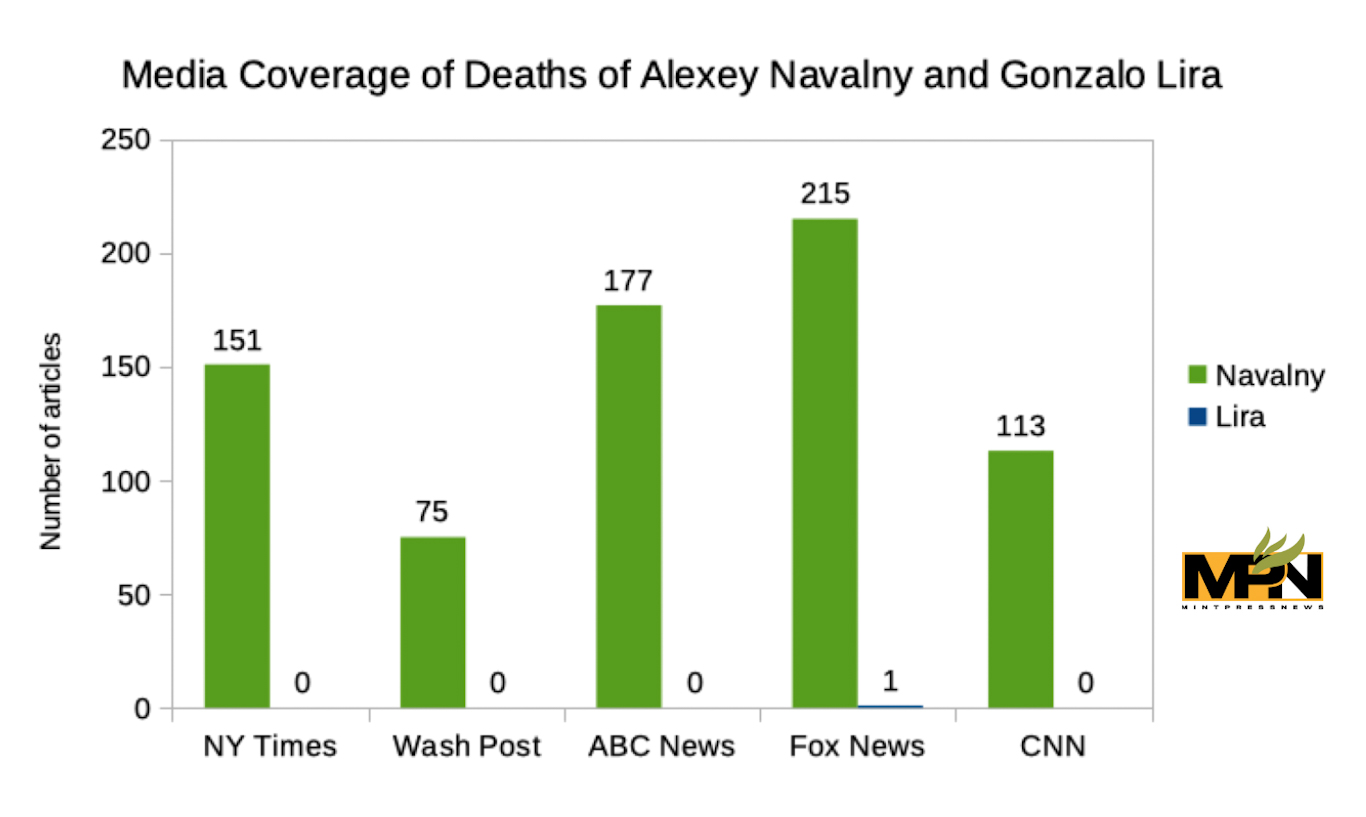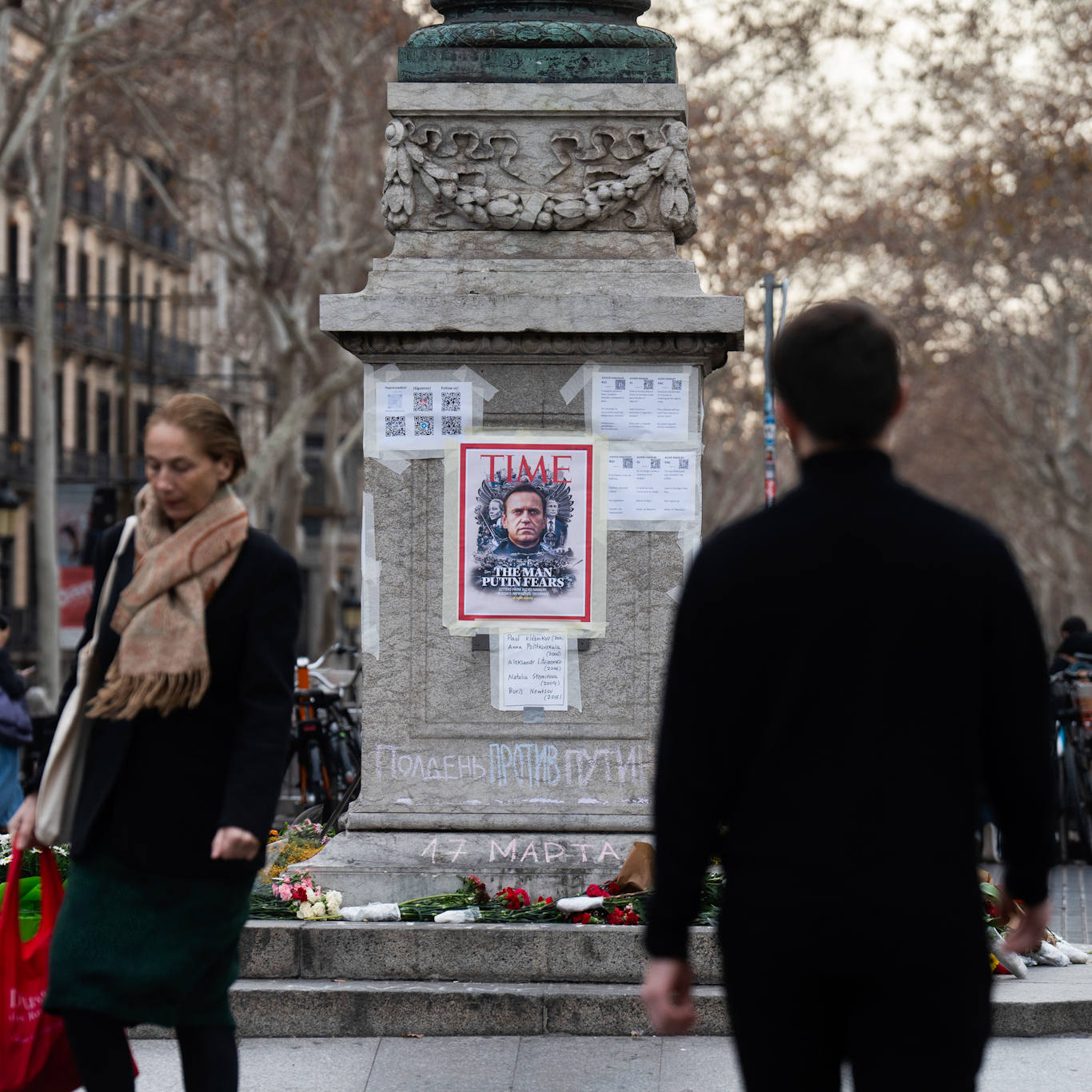A new MintPress News study of media coverage of the deaths of American journalist and commentator Gonzalo Lira and Russian political leader Alexey Navalny has found that the establishment U.S. press overwhelmingly ignored the former and focussed on the latter. The New York Times, Washington Post, ABC News, Fox News and CNN collectively ran 731 segments on Navalny between February 16 and February 22, compared to just one on Lira since his death on January 12, perhaps because one was a Western-backed figure who died at the hands of an official enemy state, while the other was a pro-Russian voice who met their end at the hands of the Ukrainian government.
Round-the-Clock Coverage vs Radio Silence
MintPress conducted a quantitative analysis of the media coverage of two political figures who recently died in prison: Alexey Navalny and Gonzalo Lira. Both were controversial characters and critics of the governments that imprisoned them. Both died under suspicious circumstances (their families both maintain they were effectively murdered). And both died in the past six weeks, Navalny in February and Lira in January. A crucial difference in their stories, however, is that Navalny perished in an Arctic penal colony after being arrested in Russia (an enemy state), while Lira’s life ended in a Ukrainian prison, abandoned by the pro-Kiev government in Washington, D.C.
The study compared the coverage of Navalny and Lira’s death in five leading outlets: the New York Times, the Washington Post, ABC News, Fox News, and CNN. These outlets were chosen for their reach and influence and, together, could be said to reasonably represent the corporate media spectrum as a whole. The data was compiled using the Dow Jones Factiva news database and searches on the websites of the news organizations. This study takes no position on the matter of Navalny, Lira, or the Russia-Ukraine war.

In total, the five outlets collectively ran 731 articles or segments that discussed or mentioned Navalny’s death, including 151 from the Times, 75 from the Post, 177 from ABC, 215 from Fox, and 113 from CNN. This means that each organization studied ran more than one piece per hour.
This media storm stands in stark contrast to the Lira case, where the entire corporate media coverage of his death boiled down to a single Fox News article. Moreover, the article in question described him as “spreading pro-Russian propaganda” in its headline, did not inform readers that there was anything suspicious about his death, and appeared to be doing its best to justify his treatment in the body of the article. Aside from that, there was radio silence.
It is perhaps understandable that Navalny’s death was covered in much greater detail than Lira’s. Navalny was a political leader known across Russia and the world who died just weeks before the country’s presidential elections.
Yet Lira was far from unknown. News anchor Tucker Carlson, for example, devoted an entire show to his imprisonment, while high-profile figures like Twitter owner Elon Musk took up his cause. State Department spokesperson Matthew Miller has been repeatedly asked about Lira’s case and has failed to offer concrete answers. As an American living in Ukraine who took a pro-Russian line on the invasion, Lira built up a following of hundreds of thousands of people across his social media platforms.
As an American citizen who died while in the custody of a government that the U.S. has provided with tens of billions of dollars in aid, it could be argued that Lira’s case is particularly noteworthy for an American audience and should be given special attention. Moreover, Lira died more than one month before Navalny, meaning that the study compares more than 40 days of Lira coverage to just six days of coverage of Navalny’s death, making the disparity all the more glaring.
A Tale of Two Deaths
Alexey Navalny was a lawyer, activist and the leader of the opposition Russia of the Future Party. A fierce critic of President Vladimir Putin, for many, especially in the West, he became a symbol of the struggle for human rights and democracy in Russia. In 2021, he released a documentary film alleging that Putin was building an enormous $1 billion palace on the Black Sea for himself.
Navalny made many enemies and was allegedly poisoned in 2020. Although most in the West believe the Kremlin was behind the incident, this is not a commonly held view in Russia. After returning from Germany for medical treatment in January 2021, he was incarcerated. On. February 16, 2024, he died at the notorious Polar Wolf penal camp in Russia’s far north.
“Vladimir Putin killed my husband,” Navalny’s wife, Yulia, said in a statement, adding, “The most important thing we can do for Alexey and for ourselves is to keep fighting more desperately and more fiercely than before.”
Western leaders are largely of the same opinion. President Joe Biden said that, while the details are still unclear, “there is no doubt that the death of Navalny was a consequence of something Putin and his thugs did.” Latvian President Edgars Rinkēvičs said that he was “brutally murdered by the Kremlin.” That’s a fact, and that is something one should know about the true nature of Russia’s current regime,” he added.
Other politicians were more cautious. “Why this hurry to accuse someone?” Brazilian President Luiz Inácio Lula da Silva (Lula) asked. “If the death is under suspicion, we must first carry out an investigation to find out why this person died,” he said.
Despite Lula’s warning, Western nations are already taking action against Russia. Both the U.S. and the U.K. have announced new rounds of “major sanctions” against Moscow, although it is far from clear to what extent previous sanctions actually hurt Russia.
Although he enjoyed a good reputation in the West, in his homeland, Navalny was a controversial character. Earlier in his political career, he was a prominent leader in xenophobic, far-right marches. He also appeared in a political video where he described the Muslim people of the Northern Caucasus as an “infestation of cockroaches.” While bugs can be killed with a slipper, in the case of human infestations, “I recommend a pistol,” he said before mimicking shooting one. According to a 2023 poll, just 9% of Russians held a positive view of him, compared to 57% who disapproved of his activities.

Lira, meanwhile, found success as an author and filmmaker earlier in life. He gained international notoriety, however, because of the 2022 Russian invasion. As an American living in Ukraine at the time, his thoughts and perspectives traveled widely. He was far from a shrinking violet, often taking a strongly pro-Russian stance on the war, labeling Ukrainian President Volodymyr Zelensky a “cokehead,” and praising Putin’s move as “one of the most brilliant invasions in military history.”
It was this sort of content that angered both the Ukrainian government and many in the United States. The Daily Beast, for instance, attacked him, describing him as a “pro-Putin shill,” and went so far as to contact the Ukrainian government to make them aware of Lira’s work. Lira confirmed that, after the Daily Beast’s article, he was arrested by the Ukrainian secret police.
He was rearrested in May 2023 and would never see freedom again. Like with Navalny, Lira’s relatives claim he was badly mistreated in prison, and they blame the government for his death. “I cannot accept the way my son has died. He was tortured, extorted, [held] incommunicado for 8 months and 11 days, and the U.S. Embassy did nothing to help my son,” Lira’s father wrote. “The responsibility of this tragedy is [with] the dictator Zelensky [and] with the concurrence of a senile American President, Joe Biden… My pain is unbearable. The world must know what is going on in Ukraine with that inhuman dictator Zelensky,” he added.
While Lira was undoubtedly far from neutral, neither was the Western press, which has largely taken a pro-Ukraine, anti-Russia stance. Like Navalny, Lira also had a controversial past. Under the name “Coach Red Pill,” he made dating and relationship advice videos for the misogynistic manosphere community, where he reportedly offered sexist advice to men such as “never date a woman in her thirties.”
A Tireless Visionary vs. Human Trash
Not only was the coverage of Navalny’s death extensive, but it also portrayed the deceased political activist in a highly positive light and gave ample space to figures claiming he was effectively assassinated by the Russian government.
The New York Times, for example, published an op-ed by Nadya Tolokonnikova of the anti-Putin punk band Pussy Riot, in which she said Navalny gave “hope and inspiration to people around the world.” “For many of us in Russia, Alexey was like an older brother or a father figure,” she said, adding:
He helped me and millions of Russians realize that our country doesn’t have to belong to K.G.B. agents and the Kremlin’s henchmen. He gave us something else, too: a vision he called the ‘beautiful Russia of the future.’ This vision is immortal, unlike us humans. President Vladimir Putin may have silenced Alexey, who died last week. But no matter how hard he tries, Mr. Putin won’t be able to kill Alexey’s beautiful dream.”
In contrast, the sparse coverage Lira’s death received in any outlet resembling a mainstream one was overwhelmingly negative. The Daily Beast, for example, ran with the headline “U.S. Finally Confirms American Dating Coach-Turned-Kremlin Shill Died in Ukraine.” Its subheadline read, “Gonzalo Lira, a blogger who pushed Kremlin propaganda in Ukraine, died after apparently coming down with pneumonia,” meaning that there was no mention of his arrest or jailing in either title or subtitle.
Most media consumers (who do little more than browse headlines) would assume from that description that an awful person met a natural death. The article went on to tear down his credentials as a journalist (which the Daily Beast used only in “scare quotes” when discussing him) and accused him of making “hysterical” pronouncements about how the Ukrainian government was after him – even though he had just died in a Ukrainian prison.
This “good riddance to bad rubbish” framing encapsulated what little coverage of Lira’s death there was in the corporate press.
Worthy and Unworthy Victims
How to explain such an overwhelming disparity in coverage? That American media have so steadfastly ignored the death of Gonzalo Lira – an American citizen – cannot be boiled down to its lack of newsworthiness. Instead, Lira is a victim of the phenomenon that media scholars call worthy and unworthy victims.
In 1988, academics Edward Herman and Noam Chomsky developed the theory of worthy vs. unworthy victims in their book “Manufacturing Consent.” Together, they compared the media coverage of various violent actions around the world in order to ascertain why certain atrocities are ignored and why others become front-page news. To Herman and Chomsky, whether the media would be interested in a violent story came down largely to two factors: who is the perpetrator, and who is the victim?
If the perpetrator is an enemy state or hostile actor, then media interest will be exponentially higher. However, if the United States or its allies are at fault, then the media is likely to ignore the story. Likewise, if the victim is the U.S. or an ally, they will receive a great deal of attention. However, the media have little interest in presenting enemy actors or states as victims, so those cases will be overlooked.
That is why Herman and Chomsky found, for example, that the coverage of one single murdered priest in an enemy nation (Communist Poland) drew more air time and column inches than the assassinations of over 100 churchmen in massacres committed by U.S.-backed groups in Latin America. In short, your death will only be covered extensively if there is political capital to be made out of it – if the incident allows media to present enemy parties as barbarous and the U.S. or friendly parties as virtuous or worthy of sympathy.
Navalny was a Western-backed political figure attempting to unseat Putin from power. His death, therefore, checks both boxes of the Worthy Victims checklist, hence the 24-hour coverage across the press. Lira, on the other hand, was a pro-Russian journalist and commentator who relentlessly critiqued and attacked the Ukrainian government. He is neither a sympathetic character in the corporate media’s eyes, nor does it make any political sense to present the Zelensky administration (whom the U.S. is steadfastly supporting) as responsible for killing an American citizen. Hence, his story is dropped and does not pass through the filters to make it onto our screens and into public consciousness.
This study is certainly not arguing that Navalny’s death is not a newsworthy event, nor that Lira deserves equal or more coverage. Nor does it take any stance on Navalny or Lira as individuals or on the wider geopolitical tussle between the United States, Russia and Ukraine. It merely uses these stories as case studies to show that what makes it as “news” in establishment media is not random but the result of an intensely politicized process. In other words, when it comes to deaths, murders or assassinations, the media will likely only cover yours if there is something to be gained from it.
Feature photo | Illustration by MintPress News
Alan MacLeod is Senior Staff Writer for MintPress News. After completing his PhD in 2017 he published two books: Bad News From Venezuela: Twenty Years of Fake News and Misreporting and Propaganda in the Information Age: Still Manufacturing Consent, as well as a number of academic articles. He has also contributed to FAIR.org, The Guardian, Salon, The Grayzone, Jacobin Magazine, and Common Dreams.
The post Worthy vs. Unworthy Victims: Study Reveals Media’s Selective Coverage of Navalny and Lira appeared first on MintPress News.
